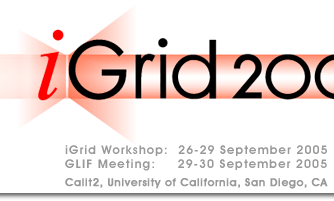News Releases
Next-generation cinema steals iGrid spotlight
By Chappell Brown
EE Times
Peterborough NH, October 10, 2005 - Ultrahigh-definition streaming media sent around the world via gigabit optical networks highlighted the capabilities of emerging scientific networks at last month’s iGrid 2005 workshop.
In the workshop, held at the University of California, San Diego’s Calit2 facility Sept. 26 to 29, NTT Labs technology demonstrated for the first time how it compresses and decompresses streams of between 6 Gbits and 4 Mbits/second for network transmission.
The workshop opened with a digital cinema demonstration. Live images from Dalsa Corp.’s Origin digital cinema camera, which produces full-motion video at 4x the resolution of high-definition TV, was piped from Tokyo to San Diego, on a route that covered some 9,000 miles. The experimental video format, called 4K digital video, is being proposed as the next-generation movie medium by a consortium of Hollywood studios.
“Seeing such dramatic examples of networked 4K media for science, medicine, education, culture, art and entertainment inspires the imagination about what can be done with advanced visualization and communications technology,” said UCSD chancellor Marye Anne Fox, who opened the iGrid 2005 event.
The demonstration was a complex blend of optical IP networking, grid computing middleware and 4K motion picture hardware, which is in research and development.
At one end of the transmission at Keio University in Tokyo was a Silicon Graphics Prism visualization system connected to a data storage system with a 1.6-Gbyte/s I/O port. Live cinema produced by the 4K camera was compressed and sent via optical network to a Visual Area Networking system at Calit2, where the images could be reviewed and edited. The demo system also used a new type of network broadcasting system developed at NTT that can stream 4K video over existing networks. The 4K digital format is now in limited use, adding digital special effects to standard films.
The demo showed that with the advent of full digital cinema technology, film crews can be working at a remote site while the director edits the daily shoots from a home office while studio executives view the film progress in a screening room in Hollywood.
To read the entire article, see: www.eetimes.com/news/latest/consumer/showArticle.jhtml?articleID=171203709


